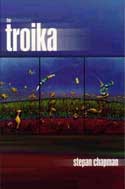 Stepan Chapman
Stepan Chapman
Ministry of Whimsy Press ($14.99)
by Rudi Dornemann
In science fiction, there's usually an inner logic to the events described, a world knit from cause and effect, an artifact created in intricate detail by the writer. This world is a signified that may, it's implied, be as important a creation as the text that serves as its signifier. Surrealism, on the other hand, places its emphasis differently. Offering a first impression as alien and unexpected as the wildest science fiction, surrealism is ordered by the aesthetics of the text and the author working behind it. The slipstream borderland between the two genres is tricky territory, marked by a tug-of-war between the imagined world's being subservient to the text and the text's being merely a window on the world the author has conjured for us. It's here at the edge-turbulence between genres that Stepan Chapman has pitched his novel, The Troika.
Surreal by the chapter, science fictional over the full arc of the novel, The Troika's connecting thread is that traditional literary standby: character. Chapman gives us three charactersEva, Alex, and Naomiand explores their various pasts, developing the tensions and bonds of their family constellation. Beyond these basics, however, things quickly get curiouser and curiouser. The characters wander an endless desert. Eva is an elderly Mexican woman; Alex, a cyborg jeep; and their daughter Naomi, a brontosaur. Storms boil up from the desert to painfully shuffle bodies and mindsNaomi wakes in the jeep, Alex in the dinosaur, etc. Life goes on like this for millennia, the characters unable to die no matter what violence is visited on them by their environment, their companions, or themselves. Nights, they tell each other stories that are as much dream as memory.
The novel shines brightest in these stories, originally published everywhere from literary magazines like Zyzzyva and Chicago Review to the annual science fiction anthology Orbit. Eva's early stories tell, with fever dream vividness, of a techno-Mayan asphalt dystopian Mexico where people have been genetically crossed with various sea creatures to breed a phantasmagoric caste system:
Eva could see people of every totem she knew. Clusters of nervous, translucent shrimp children sucked frozen custards on sticks, while parrotfish scholars in black robes pointed their staffs at Eva and shouted at the children. Spidercrab rickshaw men stood beside their rickshaws and cheered for her. They had brought lamprey women from the nurseries, who coiled in the rickshaws under parasols, their slick white bodies swollen with eggs. Eva waved to the lamprey women, and some of them waved back.
Alex's stories partake equally of Kafka and cyberpunk, describing his gradual transformation from man to machine. Chatty first-person fables set in increasingly dehumanizing versions of late twentieth century middle America, they contain the novel's more richly unsettling moments, from the first time Alex loses a hand as a warehouse worker to the final loss of his sanity as an exterminator cyborg. Naomi's stories, meanwhile, move back and forth between science fiction and horror, dabbling in different worlds and scenarios, recounting and repeating some events multiple times, at once more disjointed and more continuity conscious than the other characters tales. Through all the chaos around and within themselves, The Troika's characters maintain their identities, and Chapman maintains a consistent warmth of humanity in depicting them.
The novel that frames these stories also shifts and changes through the book. The characters' initial desert-wandering predicament has the existential spareness of Samuel Beckett. By the novel's final conflicts and resolutions, as dream stories melt and blend with the increasingly chaotic frame narrative, Chapman has moved into a kinetic fantasy mode more reminiscent of Flann O'Brien.
The key ingredient that allows Chapman to carry all this off is the tonal palette his narrative voice employs. Throughout the novel, his language is wry enough to follow the mercurial shifts of character, situation, and metaphor, where a less detached approach might risk reader whiplash. At the same time, the voice is descriptive enough to engage and envelop readers. Striking that balance once is a fine achievement for a writer, but Chapman must vary his voice to fit Eva, Alex, Naomi, the third person narrator, and a homicidal music box. It's Chapman's deft handling of this challenge that allows him to play so widely (and wildly) across the manic diversity of The Troika.
Rain Taxi Print Edition, Vol.3 No. 1, Spring (#9) | © Rain Taxi, Inc. 1998
